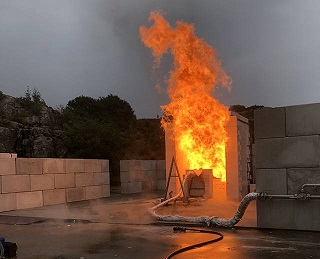Jet Fire Coating is suitable for the protection of steel, aluminium or composites from Cellulosic to Hydrocarbon Pool and Jet Fires. Tel: +86 25 86583475
Jet Fire Coating is intended to protect Structural Steel, vessels, piping, actuators, valves, piping and cable trays from hydrocarbon pool and/or jet fire to extend the functional integrity for an extended period of time. As tested by Iab, JETFIRE Coating can withstand 1400C constant temperature under ISO 22899-1 Jet Fire Standard; demonstrating a performance far and above the standard hydrocarbon pool fire (1100C).
Pool fires represent a significant element of the risk associated with major accidents on installations that may have large liquid hydrocarbon inventories.
Hydrocarbon Jet Fire vs. Hydrocarbon Pool Fire
A jet or spray fire is a turbulent diffusion flame(typically burning at + 1400°C) resulting from the combustion of a fuel continuously released with some significant momentum in a particular direction or directions.”

OTI- 95 634 / ISO 22899-1 Jet Fire Test Procedure
Fuel: Propane
Storage pressure: >2 bar
Nozzle diameter: 17.8mm
Velocity: 40 m/sec
Flow rate: 0.3 kg/sec
“A pool fire (burning at 1100°C) is a turbulent diffusion fire burning above a horizontal pool of vaporizing hydrocarbon fuel where the fuel has zero or low initial momentum.
Fires in the open will be well ventilated (fuel-controlled), but fires within enclosures may become under-ventilated (ventilation-controlled).
Pool fires may be static (e.g. where the pool is contained) or ‘running’ fires.
Pool fires represent a significant element of the risk associated with major accidents on installations that may have large liquid hydrocarbon inventories.”
Features & Benefits
UL 1709 hydrocarbon fire rated up to 4 hours
ISO 22899-1 jet fire rated from 30 minutes to 2 hours
ISO 20088-1 cryogenic spill protection to -50°C Resistant to 4 bar blast overpressure
ISO 20088-1 cryogenic spill followed by ISO 22899-1 jet fire 4 bar overblast followed by third party witnessed hydrocarbon fire
NFPA 290 simultaneous torch and hose stream resistant (extended to 150 minutes)
Nanjing SMART Products Service Co.,Ltd
Tel: +86 25 86583475 +86 25 86583465
Website: www.fire-test.com www.firete.com
Mail: info@fire-test.com
...
|
